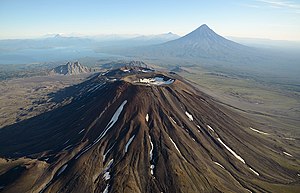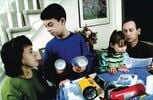
A volcano is a vent through which molten rock escapes to the earth's surface. When pressure from gases within the molten rock becomes too great, an eruption occurs. Eruptions can be quiet or explosive. There may be lava flows, flattened landscapes, poisonous gases, and flying rock and ash.
Because of their intense heat, lava flows are great fire hazards. Lava flows destroy everything in their path, but most move slowly enough that people can move out of the way.
Fresh volcanic ash, made of pulverized rock, can be abrasive, acidic, gritty, gassy, and odorous. While not immediately dangerous to most adults, the acidic gas and ash can cause lung damage to small infants, to older adults, and to those suffering from severe respiratory illnesses. Volcanic ash also can damage machinery, including engines and electrical equipment. Ash accumulations mixed with water become heavy and can collapse roofs.
Volcanic eruptions can be accompanied by other natural hazards, including earthquakes, mudflows and flash floods, rock falls and landslides, acid rain, fire, and (under special conditions) tsunamis. Active volcanoes in the U.S. are found mainly in Hawaii, Alaska, and the Pacific Northwest.
Take Protective Measures[edit | edit source]
Before a Volcanic Eruption
- Add a pair of goggles and disposable breathing mask for each member of the family to your disaster supply kit.
- Stay away from active volcano sites.
During a Volcanic Eruption The following are guidelines for what to do if a volcano erupts in your area:
- Evacuate immediately from the volcano area to avoid flying debris, hot gases, lateral blast, and lava flow.
- Be aware of mudflows. The danger from a mudflow increases near stream channels and with prolonged heavy rains. Mudflows can move faster than you can walk or run. Look upstream before crossing a bridge, and do not cross the bridge if mudflow is approaching.
- Avoid river valleys and low-lying areas.
Protection from Falling Ash
- Wear long-sleeved shirts and long pants.· Use goggles and war eyeglasses instead of contact lenses.
- Use a dust mask or hold a damp cloth over your face to help with breathing.
- Stay away from areas downwind from the volcano to avoid volcanic ash.
- Stay indoors until the ash has settled unless there is a danger of the roof collapsing.
- Close doors, windows, and all ventilation in the house (chimney vents, furnaces, air conditioners, fans, and other vents.
- Clear heavy ash from flat or low-pitched roofs and rain gutters.
- Avoid running car or truck engines. Driving can stir up volcanic ash that can clog engines, damage moving parts, and stall vehicles.
- Avoid driving in heavy ash fall unless absolutely required. If you have to drive, keep speed down to 35 MPH or slower.
After a Volcanic Eruption[edit | edit source]
Follow the instructions for recovering from a disaster in Part 5.
Knowledge Check[edit | edit source]
Read the scenario and answer the question. Check your responses with the answer key.
Scenario About an hour after the eruption of Mount St. Helens, ash began to fall in Yakima, a city in eastern Washington. The ash fall was so extensive and it became so dark that lights were turned on all day. It took 10 weeks to haul away the ash from Yakima's streets, sidewalks, and roofs. Assume you were a resident of Yakima during this time. What would you need to protect yourself when going outside?
For More Information[edit | edit source]
If you require more information about any of these topics, the following are resources that may be helpful. Publications National Weather Service Heat Wave: A Major Summer Killer. An online brochure describing the heat index, heat disorders, and heat wave safety tips. Available online at: www.nws.noaa.gov/om//brochures/heat_wave.htm U.S. Geological Survey Volcano Hazards Program. Website with volcano activity updates, feature stories, information about volcano hazards, and resources. Available online at: volcanoes.usgs.gov
